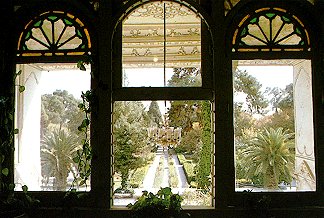|
Historical Cities of Iran
Bagh-e Eram (Qajar era), Shiraz Shiraz has been the centre of Fars Province since the 7th century AD, and it has provided a capital for several Islamic dynasties. Its most important function, has been as a major artistic centre, synonymous with learning, nightingales, poetry, roses and at one time, wine. Today, it is an important University town, and has a population of approximately 1.1 million. It was founded during the Achaemenian Dynasty, and under the Sassanians it became one on the main cities of the province of Fars. Shiraz was spared destruction during the Mongol invasion, and reached the height of its glory under the Mongols (1220 - 1380) and the Timurids (1380 - 1502). It soon came to be known as one of the leading centres of calligraphy, painting, architecture and literature. Although Isfahan became the Royal capital under Shah Abbas I (1502 - 1722) the Safavid ruler, Shiraz remained a provincial capital, and attracted a number of European traders who exported its famous wine. During this period, Emam Gholi Khan the governor of Fars built a large number of palaces and other ornate buildings. Shiraz started its decline with the Afghan raids in the early 18th century, several earthquakes in the region, and an internal up-rising. When Nader Shah was assassinated in 1747, most of Shiraz's historical buildings were destroyed. However, under the enlightened Karim Khan the first ruler of the Zand Dynasty (1747 - 1779), Shiraz flourished once again becoming a most worthy Iranian capital. Many of the most beautiful buildings in Shiraz were either built or restored in this period. In 1789 Agha Muhammed Khan (founder of the Qajar Dynasty) moved the nation's capital from Shiraz to Tehran. Although lowered to the rank of provincial capital, Shiraz maintained a level of prosperity, and it was governed by the royals throughout the Qajar period (1795 - 1925). *** To many, Shiraz is one of the most pleasant cities in Iran, with its relaxed, cultivated and generous inhabitants, wide tree lined avenues, and a multitude of monuments, gardens and mosques.
Copyright shall at all times remain vested in the Author. No part of the work shall be used, reproduced, stored in a retrieval system, or transmitted in any form or by any means electronic, mechanical, photocopying, recording or otherwise, without the Author's express written consent. Copyright © 1999 K. Kianush, Art Arena |
